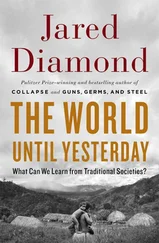Jared Diamond - Guns, Germs & Steel
Здесь есть возможность читать онлайн «Jared Diamond - Guns, Germs & Steel» весь текст электронной книги совершенно бесплатно (целиком полную версию без сокращений). В некоторых случаях можно слушать аудио, скачать через торрент в формате fb2 и присутствует краткое содержание. Жанр: 105. Описание произведения, (предисловие) а так же отзывы посетителей доступны на портале библиотеки ЛибКат.
- Название:Guns, Germs & Steel
- Автор:
- Жанр:
- Год:неизвестен
- ISBN:нет данных
- Рейтинг книги:5 / 5. Голосов: 1
-
Избранное:Добавить в избранное
- Отзывы:
-
Ваша оценка:
- 100
- 1
- 2
- 3
- 4
- 5
Guns, Germs & Steel: краткое содержание, описание и аннотация
Предлагаем к чтению аннотацию, описание, краткое содержание или предисловие (зависит от того, что написал сам автор книги «Guns, Germs & Steel»). Если вы не нашли необходимую информацию о книге — напишите в комментариях, мы постараемся отыскать её.
Guns, Germs & Steel — читать онлайн бесплатно полную книгу (весь текст) целиком
Ниже представлен текст книги, разбитый по страницам. Система сохранения места последней прочитанной страницы, позволяет с удобством читать онлайн бесплатно книгу «Guns, Germs & Steel», без необходимости каждый раз заново искать на чём Вы остановились. Поставьте закладку, и сможете в любой момент перейти на страницу, на которой закончили чтение.
Интервал:
Закладка:
372– " GUNS, GERMS, AND STEEL
remote Polynesian islands, Greenland could not support a self-sufficient food-producing society, though it did support self-sufficient Inuit hunter-gatherer populations before, during, and after the Norse occupation period. The populations of Iceland and Norway themselves were too small and too poor for them to continue their support of the Greenland Norse population.
In the Little Ice Age that began in the 13th century, the cooling of the North Atlantic made food production in Greenland, and Norse voyaging to Greenland from Norway or Iceland, even more marginal than before. The Greenlanders' last known contact with Europeans came in 1410 with an Icelandic ship that arrived after being blown off course. When Europeans finally began again to visit Greenland in 1577, its Norse colony no longer existed, having evidently disappeared without any record during the 15th century.
But the coast of North America lay effectively beyond the reach of ships sailing directly from Norway itself, given Norse ship technology of the period a.d. 986-1410. The Norse visits were instead launched from the Greenland colony, separated from North America only by the 200-mile width of Davis Strait. However, the prospect of that tiny marginal colony's sustaining an exploration, conquest, and settlement of the Americas was nil. Even the sole Norse site located on Newfoundland apparently represents no more than a winter camp occupied by a few dozen people for a few years. The Norse sagas describe attacks on their Vinland camp by people termed Skraelings, evidently either Newfoundland Indians or Dorset Eskimos.
The fate of the Greenland colony, medieval Europe's most remote outpost, remains one of archaeology's romantic mysteries. Did the last Greenland Norse starve to death, attempt to sail off, intermarry with Eskimos, or succumb to disease or Eskimo arrows? While those questions of proximate cause remain unanswered, the ultimate reasons why Norse colonization of Greenland and America failed are abundantly clear. It failed because the source (Norway), the targets (Greenland and Newfoundland), and the time (a.d. 984-1410) guaranteed that Europe's potential advantages of food production, technology, and political organization could not be applied effectively. At latitudes too high for much food production, the iron tools of a few Norse, weakly supported by one of Europe's poorer states, were no match for the stone, bone, and wooden tools of Eskimo
HEMISPHERES COLLIDING • 373
Indian hunter-gatherers, the world's greatest masters of Arctic survival skills.
the second eurasian attempt to colonize the Americas succeeded because it involved a source, target, latitude, and time that allowed Europe's potential advantages to be exerted effectively. Spain, unlike Norway was rich and populous enough to support exploration and subsidize colonies. Spanish landfalls in the Americas were at subtropical latitudes highly suitable for food production, based at first mostly on Native American crops but also on Eurasian domestic animals, especially cattle and horses. Spain's transatlantic colonial enterprise began in 1492, at the end of a century of rapid development of European oceangoing ship technology, which by then incorporated advances in navigation, sails, and ship design developed by Old World societies (Islam, India, China, and Indonesia) in the Indian Ocean. As a result, ships built and manned in Spain itself were able to sail to the West Indies; there was nothing equivalent to the Greenland bottleneck that had throttled Norse colonization. Spain's New World colonies were soon joined by those of half a dozen other European states.
The first European settlements in the Americas, beginning with the one founded by Columbus in 1492, were in the West Indies. The island Indians, whose estimated population at the time of their "discovery" exceeded a million, were rapidly exterminated on most islands by disease, dispossession, enslavement, warfare, and casual murder. Around 1508 the first colony was founded on the American mainland, at the Isthmus of Panama. Conquest of the two large mainland empires, those of the Aztecs and Incas, followed in 1519-1520 and 1532-1533, respectively. In both conquests European-transmitted epidemics (probably smallpox) made major contributions, by killing the emperors themselves, as well as a large fraction of the population. The overwhelming military superiority of even tiny numbers of mounted Spaniards, together with their political skills at exploiting divisions within the native population, did the rest. European conquest of the remaining native states of Central America and northern South America followed during the 16th and 17th centuries.
As for the most advanced native societies of North America, those of the U.S. Southeast and the Mississippi River system, their destruction was
374 " GUNS, GERMS, AND STEEL
accomplished largely by germs alone, introduced by early European explorers and advancing ahead of them. As Europeans spread throughout the Americas, many other native societies, such as the Mandans of the Great Plains and the Sadlermiut Eskimos of the Arctic, were also wiped out by disease, without need for military action. Populous native societies not thereby eliminated were destroyed in the same way the Aztecs and Incas had been—by full-scale wars, increasingly waged by professional European soldiers and their native allies. Those soldiers were backed by the political organizations initially of the European mother countries, then of the European colonial governments in the New World, and finally of the independent neo-European states that succeeded the colonial governments.
Smaller native societies were destroyed more casually, by small-scale raids and murders carried out by private citizens. For instance, California's native hunter-gatherers initially numbered about 200,000 in aggregate, but they were splintered among a hundred tribelets, none of which required a war to be defeated. Most of those tribelets were killed off or dispossessed during or soon after the California gold rush of 1848-52, when large numbers of immigrants flooded the state. As one example, the Yahi tribelet of northern California, numbering about 2,000 and lacking firearms, was destroyed in four raids by armed white settlers: a dawn raid on a Yahi village carried out by 17 settlers on August 6, 1865; a massacre of Yahis surprised in a ravine in 1866; a massacre of 33 Yahis tracked to a cave around 1867; and a final massacre of about 30 Yahis trapped in another cave by 4 cowboys around 1868. Many Amazonian Indian groups were similarly eliminated by private settlers during the rubber boom of the late 19th and early 20th centuries. The final stages of the conquest are being played out in the present decade, as the Yanomamo and other Amazonian Indian societies that remain independent are succumbing to disease, being murdered by miners, or being brought under control by missionaries or government agencies.
The end result has been the elimination of populous Native American societies from most temperate areas suitable for European food production and physiology. In North America those that survived as sizable intact communities now live mostly on reservations or other lands considered undesirable for European food production and mining, such as the Arctic and arid areas of the U.S. West. Native Americans in many tropical areas have been replaced by immigrants from the Old World tropics (especially
HEMISPHERES COLLIDING • 375
black Africans, along with Asian Indians and Javanese in Suriname).
In parts of Central America and the Andes, the Native Americans were originally so numerous that, even after epidemics and wars, much of the population today remains Native American or mixed. That is especially true at high altitudes in the Andes, where genetically European women have physiological difficulties even in reproducing, and where native Andean crops still offer the most suitable basis for food production. However, even where Native Americans do survive, there has been extensive replacement of their culture and languages with those of the Old World. Of the hundreds of Native American languages originally spoken in North America, all except 187 are no longer spoken at all, and 149 of these last 187 are moribund in the sense that they are being spoken only by old people and no longer learned by children. Of the approximately 40 New World nations, all now have an Indo-European language or creole as the official language. Even in the countries with the largest surviving Native American populations, such as Peru, Bolivia, Mexico, and Guatemala, a glance at photographs of political and business leaders shows that they are disproportionately Europeans, while several Caribbean nations have black African leaders and Guyana has had Asian Indian leaders.
The original Native American population has been reduced by a debated large percentage: estimates for North America range up to 95 percent. But the total human population of the Americas is now approximately ten times what it was in 1492, because of arrivals of Old World peoples (Europeans, Africans, and Asians). The Americas' population now consists of a mixture of peoples originating from all continents except Australia. That demographic shift of the last 500 years—the most massive shift on any continent except Australia—has its ultimate roots in developments between about 11,000 b.c. and a.d. 1.
Интервал:
Закладка:
Похожие книги на «Guns, Germs & Steel»
Представляем Вашему вниманию похожие книги на «Guns, Germs & Steel» списком для выбора. Мы отобрали схожую по названию и смыслу литературу в надежде предоставить читателям больше вариантов отыскать новые, интересные, ещё непрочитанные произведения.
Обсуждение, отзывы о книге «Guns, Germs & Steel» и просто собственные мнения читателей. Оставьте ваши комментарии, напишите, что Вы думаете о произведении, его смысле или главных героях. Укажите что конкретно понравилось, а что нет, и почему Вы так считаете.










